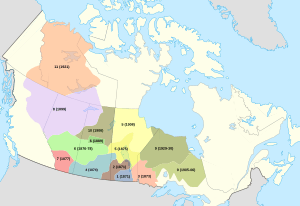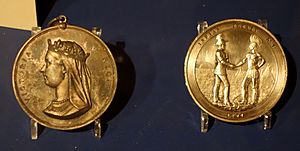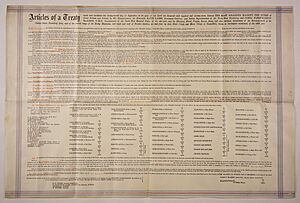Treaty 7 facts for kids
| Treaty and Supplementary Treaty No. 7 between Her Majesty the Queen and the Blackfeet and Other Indian Tribes, at the Blackfoot Crossing of Bow River and Fort Macleod | |
|---|---|

The Numbered Treaties
|
|
| Signed | September 22 and December 4, 1877 |
| Location | Blackfoot Crossing, Fort Macleod |
| Parties |
|
| Language | English |
Treaty 7 is an important agreement made between the Canadian government (called "the Crown") and several First Nation groups. Most of these groups were part of the Blackfoot Confederacy. This agreement covers land in what is now southern Alberta.
The idea for treaties on Blackfoot lands was first discussed in 1875. The main signing happened on September 22, 1877. Another signing took place on December 4, 1877, for leaders who couldn't be there for the first one. The main signing happened at the Blackfoot Crossing of the Bow River. This spot is about 100 km east of Calgary. Chief Crowfoot was a key leader who signed Treaty 7.
Treaty 7 is one of eleven Numbered Treaties. These treaties were signed between First Nations and the Crown from 1871 to 1921. The treaty set aside special areas of land called reserves for the tribes. It also promised yearly payments or supplies from the Crown. In return, the First Nations gave up their rights to their traditional lands. They were still allowed to hunt and trap on the surrendered land.
The British government had given control over Indigenous peoples and their lands to Canada in the 1840s. This power went to the government of Canada when Canada became a country in 1867. This included the area that became Alberta in 1905. Britain wanted to make sure Canada would keep the promises made to First Nations.
Contents
Who Signed Treaty 7?
The First Nations who signed Treaty 7 are:
- Bearspaw First Nation (Stoney First Nation/Nakoda)
- Chiniki First Nation (Stoney First Nation/Nakoda)
- Blood Tribe (Kainai Nation) (Blackfoot)
- Piikani Nation (Blackfoot)
- Siksika Nation (Blackfoot)
- Tsuut'ina Nation (Sarcee)
- Wesley First Nation (Stoney First Nation/Nakoda)
Why Was Treaty 7 Signed?
Life on the Plains Before the Treaty
In the late 1800s, five main Indigenous nations lived in what is now southern Western Canada. These were the Blackfoot, Piikani, Sarcee, Cree, and Blood nations. They were nomadic, meaning they moved around. They followed the large herds of buffalo. Buffalo were central to their lives and culture. They provided food, clothing, warmth, and even sacred objects.
Their lands covered parts of southern Alberta, Saskatchewan, and northern Montana. These plains were rich in buffalo. However, by 1879, the buffalo numbers had dropped a lot. This was due to too much hunting. This change meant the First Nations needed new ways to live.
Canada's Need for Land
The Canadian government wanted to build a railway across Canada. To do this, they needed to get land from the Indigenous peoples. The government suggested a treaty to the First Nations living on the plains. This was not the first treaty; there were already six others.
Treaty 7 was part of a series of eleven treaties. These were made between the Canadian government and Indigenous peoples from 1871 to 1921. Treaties 1-7 involved Indigenous groups in the west. They covered a huge area from Lake of the Woods to the Rocky Mountains and up to the Beaufort Sea.
First Nations' Concerns
The leaders of the plains nations were interested in signing the treaty. They were worried about their future. Their resources, especially buffalo, were quickly disappearing. This was partly due to overhunting and trade with companies like the Hudson’s Bay Company.
Diseases like smallpox were also a big problem. They were taking many lives, and there was no natural protection against them. The First Nations leaders were also concerned about American settlers and traders. They wondered what this would mean for their communities and culture.
They saw the treaties as a way to connect with the Queen. They hoped it would protect their land and resources. They trusted the Canadian Mounties had kept American traders out of their lands before.
The Signing Day: What Was Agreed?
Treaty 7 was signed in September 1877. It was between the Canadian government and five First Nations: the Siksika (Blackfoot), Kainai (Blood), Piikani (Peigan), Stoney-Nakoda, and Tsuut’ina (Sarcee). This was the last treaty signed in the 1870s. It would be 20 years before another treaty was signed.
The Negotiations
The Canadian government was represented by David Laird and James Macleod. Laird was the lieutenant-governor of the North-West Territories. Macleod was a commissioner of the NWMP (North-West Mounted Police). The First Nations representatives were mainly from the Blackfoot Confederacy. This was because they lived on most of the land the government wanted. Chief Crowfoot represented the Blackfoot Nation.
The signing took place at the Blackfoot Crossing. This was on the Blackfoot territory. It was a bit far for some other nations, so the meeting was delayed by two days. Laird and Macleod arrived on September 16 with the Siksika, Stoney-Nakoda, and Tsuut’ina. They waited for the others.
Negotiations began on September 19. Laird and Macleod talked about the disappearing buffalo. They offered to help the Indigenous people. They suggested new laws to protect buffalo. They also offered to teach them about farming and ranching. This would help them rely less on buffalo.
Treaty Terms
Discussions also covered yearly payments, reserve land, and education. First Nations leaders were very concerned about keeping their right to hunt and fish across all the land. Chief Crowfoot waited for Red Crow, the leader of the Kainai Nation, to arrive. Red Crow was a trusted friend of James Macleod.
Once Red Crow arrived, Crowfoot explained the treaty to him. After this, all the leaders agreed. The treaty was signed on September 22, 1877.
The treaty covered about 130,000 square kilometers of land. This land stretched from the Rocky Mountains to the Cypress Hills, and from the Red Deer River to the US border. The terms said that all nations could still hunt on the land. In exchange for giving up land, each nation would get reserves. These reserves were about one square mile for every five people in a family.
There was also an immediate payment for every man, woman, and child. Chiefs would receive $25 every year. The government also agreed to pay teachers on the reserves. Each family would also get livestock (farm animals) based on their family size.
It is important to know that there is strong evidence that the Indigenous people did not fully understand they were giving up their land forever.
What Happened After the Treaty?
Government's Goals
The government wanted the land mainly to build a railway across Western Canada. The written treaty covered a vast area. Even though the land was given up, all nations kept the right to hunt on it. However, with buffalo numbers dropping, Indigenous people wanted to learn about farming.
The government offered money, cattle, and education. Their goal was to teach Indigenous people Western ways of living. This would help them survive without the buffalo herds.
Different Understandings of the Treaty
People have different ideas about what the treaties mean. Government officials often said the treaties were like contracts. They believed it allowed Canada to take control of Indigenous lands in exchange for payments.
Indigenous people saw the treaties differently. They thought it was a way to build a connection between them and the newcomers. They needed support and protection from the Crown. They saw the treaty as a "covenant," which is a sacred promise. The government saw it as a "contract," which is a legal agreement. This difference in understanding caused problems later.
Treaty Promises
The treaty outlined specific rights for Indigenous people and support from the Queen. These included:
- The right to hunt and fish on their lands.
- Reserves of one square mile for every five people in a family.
- Rights to use certain rivers for shipping and other purposes.
- Payments of $12 to each person from the Queen. Chiefs and other leaders received more.
- Each nation would get $2000 every year for the tribe's benefit.
- Every three years, chiefs would receive medals, flags, or suits.
- The Queen would pay for teachers if children on reserves wanted them.
- Families would receive cows based on their size.
- The Queen reserved the right to punish any Indigenous person who broke the treaty.
What Were the Effects of the Treaty?
For the Government
The Canadian government wanted the treaty to build the railway and expand settlement. After the treaty was signed, government officials felt that "the Indians appeared more contented and friendly." The railway construction began in the 1880s and was completed. The long-term effects for the government have become clearer in recent years as they try to improve their relationship with Indigenous peoples.
For First Nations
For Indigenous peoples, the effects of the treaty were often difficult. The buffalo disappeared much faster than expected. The promised government support for farming did not happen quickly. The winters after Treaty 7 were very hard for the First Nations.
They faced disease outbreaks and starvation. When they finally received their reserve lands, much of it was not suitable for living or farming. The reserves often led to poverty and food shortages. Missionaries also arrived, bringing day schools and residential schools to the reserves.
There were problems with the reserves. There wasn't enough space for everyone. People worried the Canadian Pacific Railway would be built on their new land. The land itself was often poor. The promised help from the government took many years to arrive.
Lasting Impact: Different Views
Overall, Treaty 7 did not have the positive impact that Indigenous peoples hoped for. The buffalo vanished quickly. Some nations had to hunt on other nations' land. More settlers arrived, putting more pressure on resources.
The Canadian government's help for farming did not come as promised. The reserve lands were often not good enough to support the nations. Also, the harm from residential schools and attempts to erase Indigenous cultures caused deep, lasting damage. These issues have contributed to poverty and ongoing problems on reserves today.
Cultural Differences
It's important to consider the cultural differences during the treaty signing. The settlers strongly preferred written documents. However, Indigenous peoples traditionally relied on oral agreements. Because the treaty was a written document, some believe that other promises were made verbally that were not written down.
These differences in culture lead many to believe that Indigenous peoples did not fully understand what they were agreeing to. Some think that if they had known the full consequences, they would not have signed the treaties.
Moving Forward
Recently, the Canadian government has been trying to improve its relationship with Indigenous peoples. The 1982 Canadian Constitution protects the rights of Indigenous peoples and their treaty rights.
However, all the nations involved in the eleven treaties across Canada are still talking with the government. They are discussing issues like land surrenders, incorrect land surveys, and unfair deals. These discussions are still ongoing today.

Images for kids



